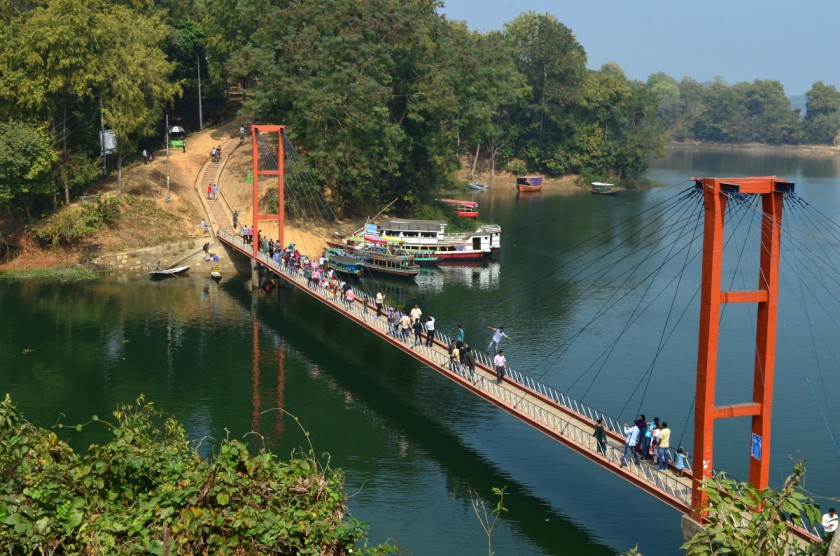Rangamati isn’t just about serene lakes and tribal handicrafts—it’s a land of hidden conflicts, vanishing indigenous cultures, and tourism’s double-edged sword. Having lived here for years, I’ll reveal what travel agencies won’t tell you—from restricted tribal zones to the dark side of the Kaptai Lake.
Why Rangamati Matters
✔ Largest district in the Chittagong Hill Tracts
✔ Home to 11 indigenous communities (Chakma, Marma, Tripura, etc.)
✔ Kaptai Lake—a man-made beauty with a tragic past
✔ A fragile peace between tribes and the government
The Dark Side of Kaptai Lake
1. The Drowning of a Civilization
- Created in 1962 by damming the Karnaphuli River
- 40,000+ indigenous families displaced without compensation
- Underwater ruins of temples and villages still visible in dry season
2. The Forbidden Islands
- Some islands are military-restricted (no tourists allowed)
- Rumor: Used for undisclosed operations
- Local fishermen report being turned away at gunpoint
Tourist Spots vs. Tribal Reality
1. Hanging Bridge (The Instagram Illusion)
- Built in 1986, now dangerously overcrowded
- Tribal vendors pay daily bribes to sell there
- Best time to visit: 6 AM before crowds ruin the experience
2. Rajban Vihara (The Monk’s Secret)
- Oldest Buddhist temple in Bangladesh
- Hidden chamber stores ancient manuscripts (access denied to outsiders)
- Monks whisper about buried treasures from the 1960s exodus
3. Tribal Markets (The Exploitation)
- Poverty behind the colorful stalls
- Handicrafts sold for pennies, resold at 10x price in Dhaka
- Chakma weavers earn less than ₹100 per day
Restricted Areas & Hidden Dangers
1. The Army-Controlled Zones
- No photography allowed near certain checkpoints
- Tourists unknowingly trespass and get interrogated
- Best advice: Stick to marked trails
2. The “Vanishing” Indigenous Villages
- Government relocations force tribes off ancestral land
- New “model villages” are tourist showcases, not real homes
- Visit the real ones? Only with a trusted local guide
Ethical Tourism: How to Visit Responsibly
Do’s
Hire indigenous guides (direct income to tribes)
Buy directly from artisans (bypass middlemen)
Respect photography bans (especially near military sites)
Don’ts
Don’t bargain aggressively (tribal sellers barely profit)
Don’t swim in restricted lake areas (hidden currents drown tourists yearly)
Don’t discuss politics (tensions still simmer)

Questions From Readers and Real Local Answers
1. “Is Rangamati safe for tourists?”
- Generally yes, but avoid sensitive zones
- Nighttime? Stick to well-lit areas
2. “Can I stay in tribal villages?”
- Some homestays allow it (ask for “community tourism”)
- Rules: No alcohol, no solo wandering at night
3. “Why no maps of certain areas?”
- Military restrictions
- Some tribal lands are undocumented
4. “Best offbeat spot?”
- Borkol Parjatan (abandoned resort with eerie lake views)
- Sajek Road’s hidden waterfalls (ask a Marma guide)
5. “What’s the biggest misconception?”
That Rangamati is just “peaceful hills & lakes”—the scars of conflict run deep.
Final Verdict: Paradise with a Painful Past
Rangamati’s beauty hides centuries of struggle. Visit with respect, awareness, and a willingness to learn—not just snap selfies.
For the real Rangamati, find me at the Kalpataru Boat Club—I’ll show you what brochures don’t.
Rangamati: Uncensored FAQs (From a Local Who Knows Too Much)
1. “Is Kaptai Lake really that peaceful?”
- Surface view: Stunning blue waters
- Underwater truth:
- 400+ submerged villages (visible in dry season)
- Tribal elders still mourn lost ancestral lands
- Night fishermen report strange lights deep below
2. “Why do army checkpoints exist in tourist areas?”
- Official reason: “Security measures”
- Local reality:
- Controls movement of indigenous people
- Prevents tourists from seeing restricted zones
- That one checkpoint near Tabalchhari never lets cameras through
3. “Can we visit real tribal villages, not just the showpieces?”
- Tourist villages: Clean, staged performances
- Actual villages:
- Need tribal guide’s permission
- No electricity after 10PM
- Prepare for heartbreaking poverty behind the smiles
4. “What’s with the ‘missing’ sections on maps?”
- White patches = Military installations
- Grey areas = Disputed tribal lands
- Local joke: “The mapmakers ran out of ink near the important parts”
5. “Is the hanging bridge really safe?”
- Built: 1986 (never properly reinforced)
- Daily load: 3x its capacity
- Secret viewing spot: The hill behind it (better photos, no risk)
6. “Why do boat operators charge different prices?”
- Tourists: ₹500-1000 for same route
- Locals: ₹50-100
- Pro tip: Find the wooden boats near Rangamati Bazar (not the fancy tourist ones)
7. “Where did all the tribal artifacts go?”
- Dhaka museums: 60%
- Private collections: 30%
- Remaining: Locked in Rajban Vihara’s secret room
8. “Can we swim in the lake?”
- Allowed areas: Near resorts (but check for leeches)
- Forbidden zones: Strong underwater currents
- Local secret: The best swimming spot is near the old Borkol jetty
9. “Why no photos of certain temples?”
- Military reason: “Security risk”
- Tribal reason: Some deities shouldn’t be photographed
- Recent incident: 2022 tourist had camera confiscated near Tabalchhari
10. “What’s the best kept food secret?”
- Tourist menus: Fried rice, chicken curry
- Real local food:
- Bamboo shoot curry (available in homestays)
- Fermented fish paste (an acquired taste)
- Tribal rice wine (not on any menu)
11. “Are the handicrafts really authentic?”
- Market stalls: 70% machine-made fakes
- Real deals:
- Chakma elder’s cooperative near Rajbon Bihar
- Marma weavers’ hidden workshop past the hanging bridge
12. “Why do resorts have two price lists?”
- Bangladeshis: Standard rates
- Foreigners: 3-5x higher
- Workaround: Have a local friend book for you
13. “Can we hike to remote areas?”
- Allowed trails: Well-marked paths
- Restricted areas:
- Landmine risks in some border zones
- Tribal territories requiring permits
- Local guide mandatory: ₹1000/day prevents trouble
14. “What happens during political tensions?”
- Internet shutdowns (last one: 48 hours in 2023)
- Increased military presence
- Tourists advised to stay near main town
15. “Where do the tribal youth really work?”
- Resorts: 20% (as low-paid staff)
- Dhaka factories: 50%
- Illegal timber trade: The unfortunate remainder
Final Thought:
Rangamati’s beauty hides generations of pain. Come as a learner, not just a sightseer. That “quaint tribal village” might be a resettlement camp. That “scenic lake” covers drowned homesteads. Tread softly. Thanks for staying with One Light Journal Bangladesh.
